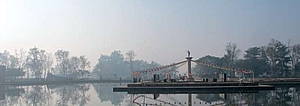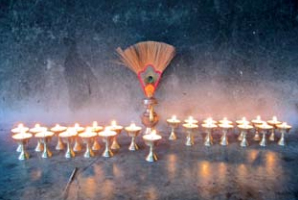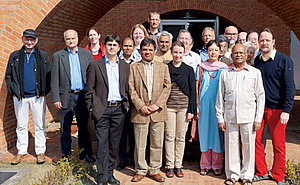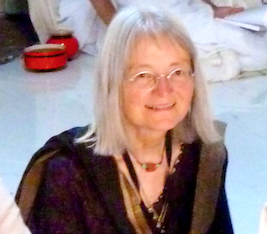
Centre of Jaina Studies Newsletter: SOAS - University of London
The Buddhist and Jaina Studies Conference organized by Christoph Cüppers and Jayandra Soni was held from 11 to 16 February 2013 in a very special location: Buddha's birth place in Lumbini, Nepal. Scholars from Austria, France, Germany, Great Britain, India, Japan, Nepal and the United States participated in the conference, which took place at the Lumbini International Research Institute (LIRI).
Peter Skilling (Chulalongkorn University) and Joseph Manuel (Archaeological Survey of India, Gwalior) set the stage with a talk entitled '"Every Rise has its Fall". Thoughts on the History of Buddhism in Central India'. They offered an impressive exposition of the archaeological evidences of the strong presence of Buddhism in Central India in the second and first centuries BCE, including recently uncovered and yet unstudied stupas. Jaina evidences from this time are hardly found. Skilling and Manuel reflected upon the gradual decline of Buddhism in the first centuries CE and on the evidences of the increase of Jaina presence.
Julia A.B. Hegewald (University of Bonn) spoke on 'Jaina and Buddhist Art and Architecture in India: Similarities and Differences'. Hegewald drew attention to many aspects in sculpture and architectural structures of both creeds, analysing and identifying special common and distinguishing features in terms of symbolism, iconography, monastic structures and monuments. In the development of the respective religions it was shown that the differentiation of ideas, concepts, views and conventions is reflected in their visual representations.
Hampana Nagarajaiah (Bangalore University) reported on 'Attacks on Important Buddhist and Jaina Centres in North Karnataka Area During the 12th Century'. He discussed epigraphs in a Śaiva temple in Ablur, a hamlet in the Haveri District, and referred to the sustained hatred by Śaivite sects towards Buddhism and Jainism and the persecution of Jainas. The epigraphs are corroborated by sculptures. Similar epigraphical records are found in several other places in the area as well
Koichi Shinohara (Yale University) discussed 'The All-Gathering Maṇḍala and the Formation of Esoteric Buddhist Ritual'. Shinohara pointed out that the sources for the early stages of the esoteric ritual tradition are preserved in Chinese translations and that the Collected Dhāraṇī Sūtras, compiled in 654 CE, contain the earliest record of the All-Gathering Maṇḍala Initiation Ceremony. He suggested that the appearance of this ritual is a part of the new post-Vedic ritual culture in medieval India and he documented this connection by some striking parallels between the ritual instruction for the All-Gathering Maṇḍala and those for representative post-Vedic rituals.

Nalini Balbir (Sorbonne Nouvelle) spoke on 'Jain Ascetic Poetry in the Isibhāsiyāiṃ and Buddhist Parallels'. Balbir revisited the probably interpolated poetic passages in the 'Sayings of the Seers' from the point of view of their meaning and their perspective. A parallel reading of Buddhist ascetic poetry proved fruitful and led to a genuine and relevant exploration of the imagery at work in the poems and to an improved interpretation of some difficult passages.
Phyllis Granoff (Yale University) gave a talk on 'Between Layman and Monk: Paścātkṛtas and the Care of the Sick in the Jain Vinaya'. Granoff explored the Jaina monastic code for instances of interaction between monks and the secular community. She described the status of paścātkṛtas, individuals who returned to secular life having been monks previously. She explored a particular situation, described in the Bṛhatkalpabhāṣya, in which they are called upon for aid, namely when a monk gets sick.


Shin Fujinaga (Miyakonojō Kōsen) presented 'Vyavahārasūtra-bhāṣya-pīṭhikā. A Preliminary Note for Jaina Vinaya', which discussed his research group's findings based on two recent publications of the Vyavahārasūtra. On one hand, the paper concentrated on a text-critique using commentarial suggestions and, on the other, examined the role of the pīṭhikā showing some important points for further studies on Jaina vinaya.
Diwakar Acharya (Kyoto University) presented 'On Avoiding all Extremes: Neti Neti, Madhyamā Pratipad and Anekānta'. Acharya compared the Upaniṣadic method of neti neti and the Jaina method of avoiding all extremes in view of their formulations and their conclusions, given the fact that in each case another aspect of reality is prevalent. However, the notion of avoiding any one-sided assertion is the basis of apprehending reality.
Volker Beeh (University of Düsseldorf) gave a talk on 'Considerations on Ātman and Related Concepts in Kundakunda's Samayasāra and Nāgārjuna'. Beeh focussed on the reflexive function of the word ātman and the difficulties arising in translating it in different languages with different concepts of reflexivity. Reflexivity is linguistically seen as an expression of circularity and this leads to problems of the interpretation of 'soul' in the mentioned works.
Jonardon Ganeri (Sussex University) spoke on 'Experiment, Imagination and the Self: The Story of Payāsi'. Ganeri presented several views of the concept of the soul. He considered its relation to the concept of the body, concepts of its essence and modes of self-awareness drawing from various traditions found in Hume, Augustine, Payāsi Sutta, Prabhācandra and Ibn Sina.
Johanna Buss (University of Vienna) presented a paper on 'The Appropriation of Buddhism by Ambedkar and the Dalit Movement' in which she presented several salient features of Ambedkar's interpretation of Buddhism, its history as Dalit-history, the twenty two oaths or the Declaration of faith and his stance relating to Hindu mythology.
Dharmchand Jain (Jodhpur University) discussed 'The Concept of Nirvikalpatā in Buddhist Logic and the Indian Tradition'. Jain presented a detailed analysis of the epistemological concept of the absence of verbal designation, its development in the Indian tradition and some references to the Jaina views. He discussed the views, for example, of Diṅnāga, Dharmakīrti and Dharmottara.
Jérôme Petit (Sorbonne Nouvelle) spoke on 'Absolute and Conventional Points of View in Jainism: A Historical Perspective'. Petit referred to the two truths pertaining to religious life defined by Nāgārjuna, namely the absolute and the conventional. He set this in relation to Kundakunda's absolute and conventional points of view to be held on the path of liberation. He then followed up the evolution of this concept in later Jaina philosophers, reformists and poets. Special emphasis was laid on the tension between the two stances in the Adhyātma movement of Jaina laity.

Peter Flügel (SOAS) considered 'The Seven Early Jaina Heresies Revisited'. Flügel investigated the selfrepresentation of fundamental principles of Jainism in the narratives of the seven Jaina heresies in the Śvetāmbara Āvaśyaka-Niryukti and its commentaries, arguing that they are not to be taken as historical events but as a thematic block of theoretical variant ontological interpretations, explicitly systematised in the commentaries. The form of 6+1+1 nihnavas may have been influenced at some stage by the 'six heresies' of Buddhism. The focus was laid on the tenets and discourse methods depicted in descriptions of the debates between Rohagupta with his non-Jaina and Jaina adversaries, which were critically analysed using models of discourse theory.
Christopher Chapple (Loyola Marymount University) spoke on 'Mahābhūta Dhāraṇas in Śubhacandra's Jñānārṇava and the Practice of the Kasiṇas in Buddhaghosa's Vishuddhimagga'. Chapple explored the meditation upon the elements in the Buddhist and the Digambara traditions, analysed the instructions of these specific concentrations and compared in detail the expositions in the two texts.
Anne Clavel (University of Lyon) presented 'Can the Rise of Rohiṇī be Inferred from the Rise of Kṛttikā? A Controversy between Buddhists and Jainas'. Clavel addressed the topic of invariable concomitance in the Buddhist and Jaina traditions. Dharmakīrti's postulations that there have to be two kinds of necessary relations, namely the relation of causality and the relation of essential identity, was rejected by Jaina logicians with counter examples, setting out cases of inference which are not accounted for by these relations. The example of inferring the constellation of Rohiṇī when Kṛttikā rises was examined in detail. The Jain philosophers held that in such a case the probans is prior to the probandum without being its cause.
In the hallowed place of Lumbini and the cultivated atmosphere of the LIRI the participants' presentations were discussed in depth. In addition to presentations, thanks to the thoughtful hospitality of Christoph Cüppers and Michael Pahlke, the participants were able to link thematically to actual places by visiting various archaeological sites around Lumbini. The genius loci created a serene ambience for this cosmopolitan meeting of scholars.
Luitgard Soni has a PhD from the University of Salzburg, and studied Sanskrit, Indian Philosophy and Hindi at the Banaras Hindu University. She was affiliated to the Department of Indology at the University of Marburg from 1992 until 2012. She works mainly on Jaina literature.
 Dr. Luitgard Soni
Dr. Luitgard Soni